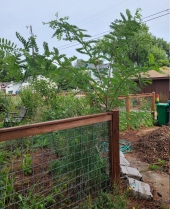posted 10 years ago
thanks for all these great posts.
another chop and drop mulch idea, this used in a major crop. Traditionally was very important in India but now most everyone burns all their mulch material.
Suresh Desai
President, Organic Farmers Club, Bedkihal, Taluka Chikodi, Belgaum-591-214
Ph.: 08338 261052, Cell: 09480448256
Global Green Agricultural Society, Swastik Plaza, Behind Pearl Hotel, Tarabai Park, Kolhapur, Maharashtra, India
Suresh Desai has achieved a production miracle in organic sugarcane farming through an innovative mulching system devised entirely on his own. His approach is that whatever elements are essential to sugarcane (or any other crop) should be supplied through the medium of a multi-mix of vegetation that has decomposed. This is achieved he says by microbial saturation, catalyzed by mulching, in the treated soil. This resulting biomass product of mulching is known as ‘Aurogreen’ in honour of the activities of the Maharishi Aurobindo Ashram.
‘Aurogreen’ is a mixture of nitrogen fixing legumes such as green-gram, horse-gram, black-gram and beans, oil seeds such as sesame and Karla (blace sesame), chilli and aromatic seeds such as dhania (coriander) and other such locally available greens.
There is a certain proportion in the quantities of various seeds which are to be grown using the Aurogreen mulching method. For a land of around 40 gunte (1 acre), five kg horse-gram, 1 ks dhania, 200 grams rajgira, 200 grams black sesame, 200 grams white sesame, 500 grams methi, 1 kg black gram, 500 grams chili, 1 kg green gram, 500 grams beans are to be mixed and sown in the spaces between each rows of the main crop. When these germinate and some growth has been achieved, this supportive vegetation is cut down and mulched below the canopy of the plant of the main crop.
Non- leguminous mulching biomass in which the C:N ratio is over 120 should be avoided, because it does not provide essential elements in the proportion needed. In Aurogreen mulching the C: N ration is maintained between 20-30, which is most suitable for developing sufficient quantities of microorganism species, leading thereby to rich bio-diversity in the soil.
Of the mixture of supportive vegetation, coriander and horse-gram are primarily used for their medicinal properties. On the surface layer of each leaf are acids, namely oxalic and malic acids. These two acids are the basic bond of a variety of amino-chains, which have important medicinal characteritics. In comparision to other green, leafy vegetables, coriander leaves and stems have several more micro and trace elements in organic and degradable forms for the bacteria and fungi in the soil to feed on.
The spacing between two sugarcane rows as well as each sugarcane plant in a row is kept at nine feet. Each of these give around 10 sprouts which works out to around 40,000 plants per acre of land. The population thereby reaches the same quantities as that planted by farmers using chemicals. Significantly, the direction of planting is kept in a North-South direction ensuring that all the leves of the sugarcane as well as the Aurogreen vegetation on the land get the maximum amount of sunlight. The heat generated by this is good for the mulching process. Because the leaves are exposed to direct as well as indirect, percolated sunlight, the process of photosynthesis is enhanced, leading to greater production of food/sugar content in the plants.
The tonnage of sugarcane achieved by Suresh Desai is substantially higher that that produced on chemical farms. Besides this, his methods have ensured a big saving in water usage for a crop which has always been known to be a water guzzler. Nine to 10 irrigations for the entire duration of the crop are now sufficient because the soil has increased its capacity for retention of water. The soil becomes rich in organic matter and in, as he calls it, bio-film – a rich, loamy layer of soil that is densely polullated, not only by earth fauna, such as earthworms, but one that is taken over by earth colonies of beneficial fungi, aiding and enhancing the process of decomposition.
Though having done only secondary school, this farmer aged 57 is a voracious reader and enthusiastic experimenter. Inexpensive farming has interested him from the begining. In 1972 he began thinking that green bio-mass could be given directly to plants instead of composting! In 1973 he stopped burning the ‘waste’ on all of the 12 acres on which he grows sugarcane. He made use of the green bio-mass to cover the land rather than putting it into the ground. He also thought that drip irrigation was an expensive proposition and so devised an ‘appropriate technology’ using the same principle, viz not allowing the water to sink too deep into the land but instead seeing that it flowed parallel to the land and fed the plants. He says that just as chemicals put into the land kill microorganisms and ruin the fertility of the soil, excess water too proves fatal to these microoganisms.
Charlotte Anthony
The Mother Who Plants Trees
http://www.handsonpermaculture1.org
victorygardensforall@gmail.com










